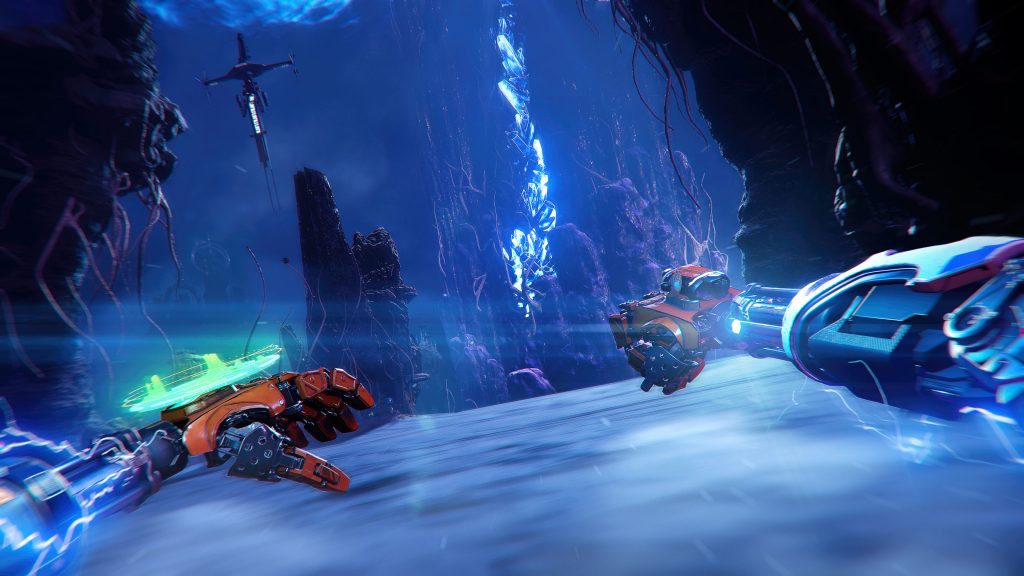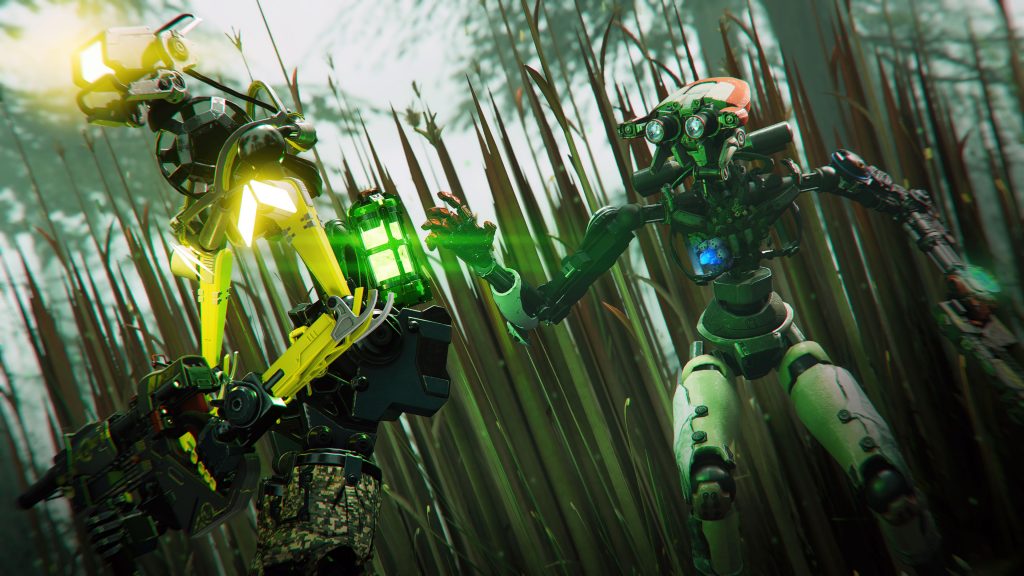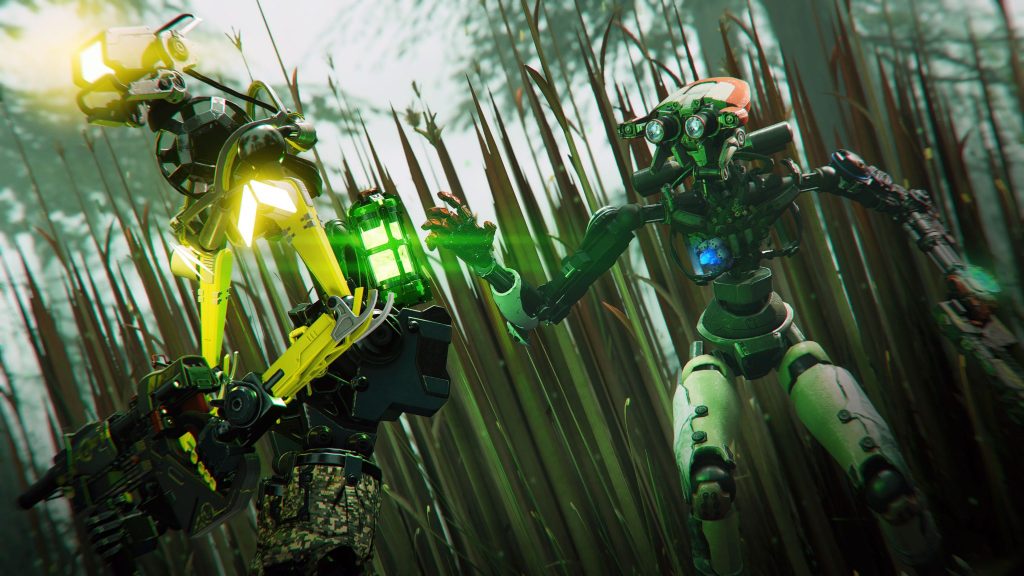
It feels like we’re maybe starting to see VR come into its own with bigger, meatier games that feel less like “experiences” and more like…er, well, games. Not long ago Asgard’s Wrath provided us with an immense RPG spanning dozens of hours that was built from the ground up for virtual reality. Now we’ve got the maestros at Insomniac with their latest effort, Stormland VR, a shooter with an interesting end-game and some of the best virtual reality arms around.
You play as a robotic gardener named Vesper who awakens to find his robotic pals missing at the hands of mysterious invaders known as the Tempest. From there it’s a quest to find out what happened, rescue your friends and shoot a bunch of stuff in the process. While the story itself is nothing special, although certainly enjoyable, I was more impressed with the quality of the voice acting. It’s superb throughout, and because of it I quickly found myself getting attached to a few of the characters.
It might sound strange to anyone who hasn’t experienced VR yet but one of the things I love in Stormland is that you have fully animated arms. Often in VR games this can be distracting because the way they move can look horrifying, with wrists and elbows bending into unnatural positions. But Stormland nails it. Your robotic elbows bend perfectly, and your wrists look natural as it swivels and tilts. Of course, being a robot in-game helps since it hides some of the stiffness of the animation. You aren’t just a pair of floating arms, either – you’ve got a whole body, and it really helps to enhance the immersion when you can glance down and feel like you’re actually in the world.

Available On: Oculus
Reviewed On: Oculus Rift S
Developer: Insomniac
Publisher: Oculus Studios
Review code provided free of charge by Insomniac
If you want to run the game at max settings then you’re going to need some pretty good hardware, but the results are nothing less than great. Insomniac have packed a lot of detail into Stormland. I spent a lot of time just staring at the character models for the various robots you encounter, or admiring the alien fauna found on of the many floating islands high up in the sky.
Ah, yeah, we need to talk about the world of Stormland. The whole game takes place in three different cloud layers, thousands of feet in the air. Among the vast expanses of clouds are floating islands where most of the action takes place. Whenever you venture onto the rolling clouds your thrusters are activated and by holding your arms out in front of you like Superman you can surf along the top of the clouds. Holding the grip buttons boosts your speed, and by skimming special blue beacons you get even faster. The act of holding your arms out seems to help negate any feeling of nausea, at least for me. And hurtling along feels awesome. It gets better, too, with a later upgrade that lets you create updrafts, firing you into the sky.
In fact, movement in general is something Stormland absolutely nails. When you leap off of something you can hold your arms out to glide around which feels terrific. Finally, almost any surface can be climbed, giving you a fair amount of freedom when it comes to tackling various islands. With a quick downward movement of your arm you can propel yourself huge distances up or along cliff faces, metal walls and more. Once you get the hang of it all you can smoothly dart around the environment and pull off some brilliant moves, from simply reaching a high spot for some sniping to hanging off the side of a cliff while firing off a shotgun before leaping down and going to town.
Admittedly it does take a strong stomach to handle some of it. Stormland VR is a fast-paced game, and I’d definitely sate its one of the tougher games to deal with. Luckily there’s plenty of comfort options for those who struggle. You can turn on vignetting, change how quickly you get up to speed, turn on snap turning and more. However, there are no options for teleportation and a lot of the game is built around the climbing and your movement. In short, if you suffer from sickness when playing VR games it might be best to avoid Stormland.
There’s a fair amount of the old shooty-shooty to be done in Stormland, so it’s a good thing it handles gunplay rather well. While you only get a few different guns (an SMG, a carbine, a sniper rifle etc.) they each feel good to use, every bullet of the trigger resulting in a satisfying explosion of noise. You can fire them one-handed if you like or dual wield for extra badasserry, but if you hold them with both hands you get a fun little transformation animation and an added bonus like better accuracy or a higher rate of fire.

Reloading your weapons in VR can often be a fiddly affair, which is presumably why Insomniac decided to skip it entirely. Instead, when you run out of ammo you just grab a new gun from a fallen enemy and rip it apart to earn resources and bullets. It’s weirdly satisfying to dismantle all the spare weapons, although you do have to be careful because the game does have a habit of grabbing the top of a gun for ripping it apart when you’re actually trying to use a two-handed grip. This led to a number of embarrassing situations where I wrenched apart my gun in front of the robotic enemies.
The way the world is divided into multiple islands gives Stormland VR an almost Far Cry feel to the action, with each island being like an outpost. The way the movement works gives you pretty much free reign to go in from any angle. You even have a handy sensor you can activate by bringing your hand up to your forehead. And if going in guns blazing feels like to much physical effort (you can play sitting down, if you like) then there’s even some basic stealth on offer with large patches of grass hiding you from sight. Once you get up behind an enemy robot you can yank out their power core for an instant kill.
It’s like Insomniac built a fantastic set of gameplay mechanics but struggled to design a game around them. Moving around, planning out an attack and combat are all heaps of fun. However, the mission structure never evolves past the feeling that you’re tackling little Far Cry outposts. While there’s a nice variety in enemies their very basic, often dumb A.I. doesn’t help with the feeling of repetition. Every mission simply sends you to an island to flip a switch or something like that. There’s nothing that really breaks up that formula over the five or so hours it takes to complete the campaign.
Maybe that’s unfair, because Insomniac’s reason becomes clearer at the end of the game, whereupon a slightly confusing system comes to the fore. Basically, once the last mission is done you return to the Stormland with a new objective: progress back through the 3 environments and beat the Terminus mission again which sees you tackling a fortress full of bad guys. Succeed and your progress is reset, the items and blueprints you’ve gotten vanishing into the mists of time. But you do get rewarded with Growth which you then use to unlock new upgrades for your character. You only get a week to do this however, because every Tuesday the world cycles, changing up the levels and scannable items and such. With a total of 16 “worlds” currently available to cycle through it will take around four months to see it all. When you jump into a new cycle you once again go through the 3 different areas and tackle Terminus. Each successful completion of Terminus bumps up the Escalation level, which in turn increases the power of the enemies. Finally, if you beat Escalation level 2 you get a special cinematic.

Initially it sounds cool, and the promise of months of content is excellent. Except…there really isn’t. After spending 5 hours doing the same basic missions over and over the end game content offers exactly the same, but repeated even more. Sure, it’s fun to see some variations in the map and fight trickier enemies, but the appeal wears off fast. There aren’t even any special weapons, skins or other cool rewards on offer. Right now, I can’t see why I’d want to return every week for months on end. Perhaps I’ll leap back in a few times just because the movement and shooting feels so great, but that’s it.
It’s worse when you compare Stormland VR, a £40 VR game with a 5-hour repetitive campaign and end game, to Asgard’s Wrath, a £25 VR game that boasts 40+ hours of action.
To help ease the sense of repetition you can play through most of Stormland VR in co-op, and as you’d expect having a friend along for the ride does make things a lot more fun. But then, just by being there friends typically make everything more fun, so what does Stormland actually do to make its co-op special? The answer is nothing. There are no true co-op mechanics that ask you to work together. Instead, it’s more like two people playing a solo adventure that just so happens to be taking place in the same world. Still, you can pull off some cool stuff, like throwing a gun or health canister to your chum.
Whether you’re on your own or playing with a friend you spend a fair amount of time gathering various alloys from around the map. These can then be spent to build or upgrade guns, or to fabricate handy items like grenades and health canisters that you strap to your chest.
Then there are special Aeon Buds that let you boost your core stats and abilities, while Growth is needed to unlock extra slots. You could maybe grab an upgrade reveals weak points on enemies or that has a chance of making a foe explode upon death. One of my personal favourites adds a special area-of-effect attack when you hit the ground from a height, providing some extra encouragement to make use of the climbing mechanics. Who doesn’t love dropping in from a cliff before whipping out a shotgun? Aside from the poor bastards on the other end of the shotgun, of course.

There’s a lot of nice design choices that make good use of VR, the kind that show the industry is starting to get to grips with virtual reality. Bring up your left hand, for example, and there’s a handy compass on your wrist which displays the next objective. By tapping the map tab next to the compass you can view a fantastic 3D map and pop down a custom marker just by touching the spot with your finger. Flip your hand over and it brings up a menu where you can check out handy information by using the finger of your other hand to navigate the screen. It’s terrific stuff and feels so natural. Likewise, using things like the crafting table is easy and intuitive thanks to the pop-up holographic menus.
While the controls are mostly excellent there were some moments of confusion. You can grab any gun with your other hand as we covered, but you can also grab the top of the weapon then rip the gun apart to collect resources from the debris. That’s fine, but over a dozen times in the heat of the moment I’d find my gun torn to little bits, which does make shooting stuff tricky. I also found weapons going missing, either simply disappearing or failing to go into their holster.
But for the most part Stormland is actually a pretty smooth experience. I never encountered any major bugs or glitches outside of a few enemies failing to register my presence. And once I got the settings tweaked the framerate stayed steady apart from one or two moments where they dipped down.
Stormland certainly has issues and questionable design choices, then, but ultimately I still enjoyed playing it. It’s yet another strong VR exclusive, following hot on the heels of Asgard’s Wrath. This is the kind of output we need to see to help grow virtual reality gaming, games that provide a meatier time than just a novelty experience. However, as strong as the shooting and movement is in Stormland the basic mission structure needed to be so much more substantial than it is. So in order to enjoy Stormland VR you need to go in with the right expectations. Do that and you’re in for a good time, courtesy of Insomniac who continue to be one of the greatest forces in the industry today.
3.5 out of 5





